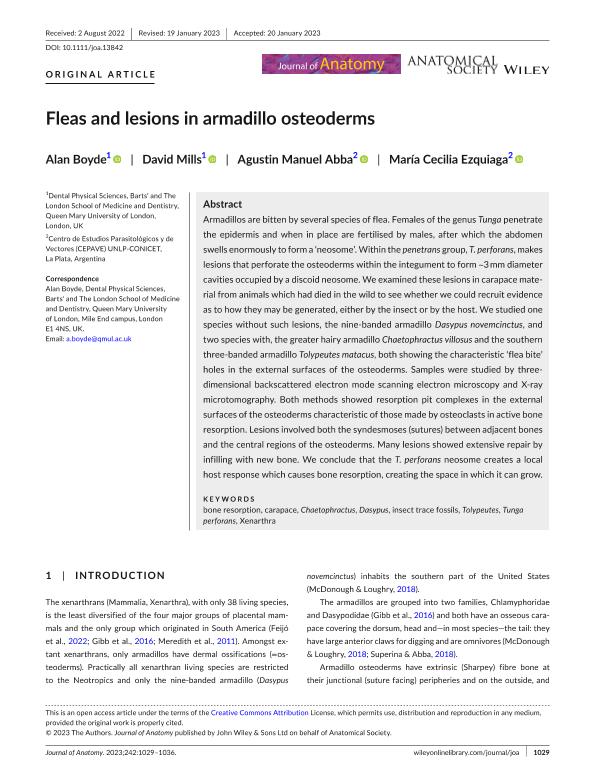Artículo
Fleas and lesions in armadillo osteoderms
Fecha de publicación:
06/2023
Editorial:
Wiley Blackwell Publishing, Inc
Revista:
Journal of Anatomy
ISSN:
0021-8782
Idioma:
Inglés
Tipo de recurso:
Artículo publicado
Clasificación temática:
Resumen
Armadillos are bitten by several species of flea. Females of the genus Tunga penetrate the epidermis and when in place are fertilised by males, after which the abdomen swells enormously to form a ‘neosome’. Within the penetrans group, T. perforans, makes lesions that perforate the osteoderms within the integument to form ~3 mm diameter cavities occupied by a discoid neosome. We examined these lesions in carapace material from animals which had died in the wild to see whether we could recruit evidence as to how they may be generated, either by the insect or by the host. We studied one species without such lesions, the nine-banded armadillo Dasypus novemcinctus, and two species with, the greater hairy armadillo Chaetophractus villosus and the southern three-banded armadillo Tolypeutes matacus, both showing the characteristic ‘flea bite’ holes in the external surfaces of the osteoderms. Samples were studied by three-dimensional backscattered electron mode scanning electron microscopy and X-ray microtomography. Both methods showed resorption pit complexes in the external surfaces of the osteoderms characteristic of those made by osteoclasts in active bone resorption. Lesions involved both the syndesmoses (sutures) between adjacent bones and the central regions of the osteoderms. Many lesions showed extensive repair by infilling with new bone. We conclude that the T. perforans neosome creates a local host response which causes bone resorption, creating the space in which it can grow.
Archivos asociados
Licencia
Identificadores
Colecciones
Articulos(CEPAVE)
Articulos de CENTRO DE EST.PARASITOL.Y DE VECTORES (I)
Articulos de CENTRO DE EST.PARASITOL.Y DE VECTORES (I)
Citación
Boyde, Alan; Mills, David; Abba, Agustin Manuel; Ezquiaga, María Cecilia; Fleas and lesions in armadillo osteoderms; Wiley Blackwell Publishing, Inc; Journal of Anatomy; 242; 6; 6-2023; 1029-1036
Compartir
Altmétricas




